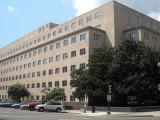(CIDRAP Business Source Osterholm Briefing) – So, is the H1N1 pandemic over or just taking a break? What should you tell your organization about the days ahead? What can you say about a possible a third wave of illness or even what to expect with seasonal influenza?
We're at a critical crossroads, colleagues. How you answer these questions and interpret information will affect both your organization's preparedness for the short term and others' perceptions about your ability to predict future risk. Your pandemic messaging today and your track record will be judged long after this pandemic has passed. Credibility is at stake. Let's make sure it's not a casualty. I think I can help you with that important task.
History, not purported experts, will have the final say on H1N1
You've no doubt seen or heard so-called "experts" pronounce the complete and final dénouement of the novel H1N1 pandemic on the pages of newspapers, on Web sites, and in broadcast sound bites. Wouldn't we all like to put the pandemic behind us? Resist the temptation, as hard as it is. If I have one critical message for you today it's this: Never forget this simple influenza mantra—expect the unexpected.
I fully support the recommendation by the emergency committee of the World Health Organization (WHO) on Feb 23 to maintain the current pandemic alert level, and I urge you not to let your guard down with novel H1N1.
So what evidence warrants keeping the H1N1 pandemic on the risk radar screen? Let me explain.
Too many people are still vulnerable to H1N1 infection
The consensus of analyses presented to date makes clear that only half (or less) of the world's population (1) has been infected with novel H1N1 and is now immune until the virus makes some big genetic changes, (2) has been vaccinated with the new vaccine, or (3) has some immune protection remaining from exposure to a similar virus that circulated more than 60 to 70 years ago. That leaves a considerable number of vulnerable people who could become the tinder for a third wave yet this spring or even during next winter's flu season. Among them are people in the United States and Europe, where the availability of vaccine still hasn't moved us much beyond the estimated 50% of the population now considered protected.
Bear in mind that that in Europe and Asia, most deaths associated with the 1968 H3N2 pandemic occurred a full year after the virus first began circulating. While I agree that having a large population that is still susceptible to the novel H1N1 virus doesn't guarantee that another wave will occur in the upcoming months, we simply cannot dismiss that possibility.
The myth of 'herd immunity'
Some of the so-called expert commentators on the influenza pandemic have referred to an epidemiology concept called "herd immunity" to justify why they think we won't see another influenza wave this year. In short, this concept, which is based on having a sufficient number of a population protected against infection so that the causative agent can't find enough susceptible individuals to keep circulating, is full of pitfalls when applied to influenza. The topic of herd immunity is worth an entire column. But in short, please understand that herd immunity isn't going to keep us from seeing additional illness caused novel H1N1 influenza. Period.
Despite lukewarm interest among your colleagues in getting an H1N1 vaccine, please keep encouraging them to get immunized! The number of cases of influenza in our communities could change quickly. If that occurs, we won't be able to immunize many of those who will suddenly be scrambling to get the vaccine in just a few days.
H1N1 is still active in parts of the world
As of now, there is no evidence that novel H1N1 virus is causing pandemic-like levels of illness anywhere in the world. Please bear in mind, however, that the virus is still active in Eastern Europe, Central Asia, and Western Africa. Even in the United States, we continue to see sporadic H1N1 activity, particularly in the South. It's worth noting that many countries in the Northern Hemisphere have had two pandemic waves of H1N1 illness, while many countries in the Southern Hemisphere have experienced only one. These countries are just now entering the period of seasonal influenza and could provide new energy to another H1N1 wave. Time will tell.
A different lens on what's happened so far
As we all know, the public health establishment as well as governments around the world have come under fire for having overreacted to the H1N1 pandemic. It wouldn't surprise me to hear that you have felt the heat of questions about the big deal made of a "flu crisis" that didn't seem even as severe as a typical influenza year.
Drawing such a conclusion is just plain wrong.
I'm currently working with a group that is conducting a detailed analysis comparing the number of deaths due to previous influenza pandemics as well as previous seasonal influenza years and what has happened with H1N1 over the past 10 months. In short, both the 1957 and 1968 pandemics mirrored the illness and death picture of seasonal influenza, but with many more cases. With such a pattern of influenza, most of the deaths occur among those who are older than 65 years of age and who often have other underlying health problems that contribute in a major way to the severity of illness or death.
But with H1N1, more than 85% of the deaths worldwide were among people younger than 60 years of age. Using the lens of years of potential life lost at age 65 (as our group has in its preliminary analysis), suddenly the H1N1 pandemic takes on a new perspective. This analysis is a way to measure the disproportionate impact of a disease and its related deaths among children and young adults compared with those among the elderly. I will report in detail on this analysis in a future column, but in short, I can tell you that the years of potential life lost with H1N1 are similar to if not higher than those associated with the 1968 pandemic.
As I discussed above, we may be a long way off from writing the obit for this current pandemic. No, the world did not overreact to the novel H1N1 pandemic. Thank goodness it hasn't been a 1918-like experience. But the first pandemic of the 21st century has done a lot more health damage than has been clearly described to date.
Bottom line for your organization
The H1N1 pandemic is not over yet. Keep trying to get your colleagues and loved ones vaccinated. And when the final history is written on this pandemic, the real health impact will justify all of your preparedness efforts.


















